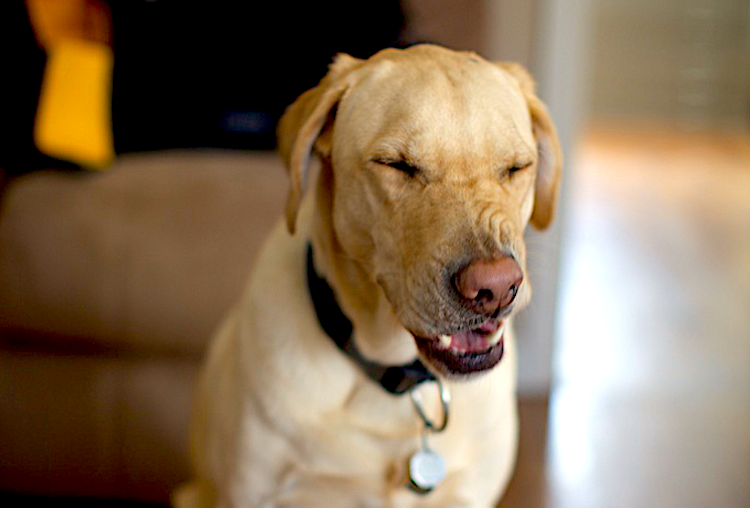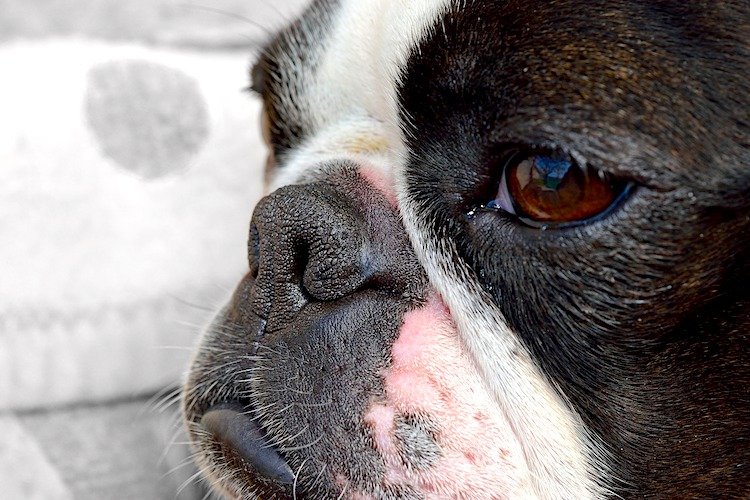Reverse Sneezing in Dogs: Yes, It’s a Thing (Here’s What to Know)
Episodes of reverse sneezing in dogs usually last a minute or less. This snorting is your dog’s attempt to clear the back of their throat from irritants.

Go for it, loving dog person. Impersonate your pup’s reverse sneezing!
Cough, gag, sneeze, make disgusting sounds in my exam room so you can explain to me what your pup has been doing. People love to perform this phenomenon. As a veterinarian, I love it, too.
Reverse sneezing in dogs is a common occurrence. Vets like me get calls about these episodes all the time. They are almost always not a serious problem but can be very upsetting to the pet parent — and the dog certainly seems confused and somewhat distressed.
The classic “reverse sneeze” episode comes on quickly and, excuse the pun, reverses quickly. The weird sneezing episode usually lasts under a minute or is gone within a few minutes.

Don’t leave your pet’s safety to chance
Sign up for Petful recall alerts today.

At-Home Diagnosis: Just Watch This Video
Words are just dumb when trying to describe reverse sneezing, since a video is worth a thousand words. If you think your dog is experiencing this problem, take a look at this video and you probably have your diagnosis:

While your pup is honking, sounding like they can’t get a good breath, take a breath yourself, take a video, and your dog’s weird episode will most likely be over.
Save the video to show your veterinarian. Of course, no diagnosis is always that easy. Even vets post videos of their patients with reverse sneezing and show the videos to veterinary respiratory specialists just to confirm the diagnosis.
Although most video images confirm that a reverse sneezing episode is highly likely, there are complicated cases or cases that are not that straightforward. More on that later.
If you want a medical description, the VINcyclopedia of Diseases from the Veterinary Information Network describes reverse sneezing as audible paroxysms of strong inspiratory efforts made against a closed glottis.
Translation: A reverse sneeze is the body’s attempt to clear irritants from the back of the throat.
Humans Mimic Reverse Sneezing Very Well
Vets love to share stories about clients who mimic the reverse sneeze in our exam rooms.
Dog parents honk and snort, with full sound effects and bodily contortions. I have often had to stop the performance and explain to the person that I think I’ve got it.
“Sir, no need to continue snorting, writhing and addressing your head toward the floor so as to look like a Beagle ready to give it all up with a massive mucus sound.”
Given that I was in practice long before the days of easy cellphone videos, reminisces of my Boston Terrier–impersonating clients snorting and contorting are still vivid.
Today, lots of people still begin their description of why they have brought their dog in for presumptive reverse sneezing by creating a disgusting sound in the back of their throats and beginning to enact a minor heaving maneuver.
Before I get really concerned they might try to throw up on my floor, they say, “Wait! I have a video from the last time she did it.” Thank you.
Reverse sneezing documentation is a great use of cellphones.
What Is a Reverse Sneeze?
This snorting is your dog’s attempt to clear the back of their throat from irritants.
Here’s a medical description that has helped me explain the difference between sneezing and reverse sneezing to many clients:
- Sneezing (forceful expiration from the nose) occurs in the front of the nose. This is a normal reflex to an irritant in the front of the nasal cavity.
- Reverse sneezing occurs in the back of the nasal cavity. Reverse sneezing in dogs is much more common than it is in humans.
The closest thing that humans experience to a “reverse sneeze” episode is usually an allergic postnasal drip–type syndrome when yucky stuff coagulates in the way back of the throat and we want to do something like snort the stuff either up, down, or elsewhere and “clear our throats,” so to speak.

Causes of Reverse Sneezing in Dogs
Any irritant to the nasal cavity, the throat or the sinuses can result in a reverse sneeze. These can include:
- Allergies
- Nasal mites
- Foreign bodies, such as blades of grass or foxtail
- Infections of the nasal cavity or sinuses
- Excessive secretions
- Growths in any of the associated cavities
- Anatomical issues, such as brachycephalic syndrome (short-nosed dogs)
Or perhaps it’s idiopathic.
That’s the medical term we use when we have no idea what is causing something to happen.
Many cases of reverse sneezing wind up in the idiopathic category because there is no easily identifiable cause and the reverse sneezing is mild and self-limiting.
Treatment of Reverse Sneezing in a Dog
No treatment is needed in most cases. Once you know what reverse sneezing is, know that it will be over soon and know your dog is not in any danger, you can relax.
It has been suggested that you can pinch the dog’s nose (not always that easy!) and soothe the throat or lightly blow in the face.
- Nasal mites are a possibility in cases that are going on for a while. Empirical treatment can be given to dogs with ongoing reverse sneezing, particularly dogs who have been recently or frequently boarded. Empirical treatment means we can’t necessarily diagnose nasal mites easily but can safely treat them with a highly effective medication.
- Corticosteroids and/or antihistamines are used in refractory cases, particularly if we think the reverse sneezing is allergy-related. I usually try a short course of prednisone, and the response is often excellent. Cerenia is another drug with many uses.
Some patients prone to reverse sneezing also love to stick their snouts where they don’t belong.
Common sense dictates that dogs who love to dig ditches with their noses, try to root out existing or nonexisting vermin by face-planting in dirt, or generally just explore the world through their noses should be kindly asked to stop this activity if they are experiencing episodes of reverse sneezing. Beagles come to mind.
Full work-ups for reverse sneezing are indicated only in dogs who experience a sudden onset of continual or frequent episodes that are not improving.
Diagnostics including examination of the oropharynx, rhinoscopy, radiographs and/or advanced imaging are indicated in worrisome or atypical cases.

Is Your Dog at Increased Risk for Reverse Sneezing?
The answer is no. Studies do not show a true breed predilection for reverse sneezing.
People with breeds prone to airway disease, however, should pay special attention.
- Short-snouted dogs (brachycephalic breeds) can suffer from various breathing problems due to their anatomy. Reverse sneezing episodes in these breeds can be more serious.
- Small breed dogs are prone to tracheal collapse, and sometimes it is difficult to completely discern tracheal collapse episodes from reverse sneezing. Your vet can help you with this problem.
My experience in rural practice reminds me that hunting breeds like Beagles were way overrepresented for episodes of reverse sneezing.
While writing this article, I probably looked at 20–30 videos of reverse sneezing posted by vets for vets.
Although the answer is usually the same — that the humans are more concerned than their dogs, that the episodes are not dangerous and that the patients are going to be OK — I was nevertheless reminded that people can get really upset about this syndrome.
So, take your videos to your vet. Document the severity and frequency of the episodes, and go from there. For the vast majority of dogs, reverse sneezing is more concerning to people than to canines.
References
- Shell, Linda, DVM, DACVIM. “Reverse Sneeze.” VINcyclopedia of Diseases. 2012.
- Kuehn, Ned F., DVM, DACVIM. “Introduction to Lung and Airway Disorders of Dogs.” Merck Veterinary Manual. June 2018. https://www.merckvetmanual.com/dog-owners/lung-and-airway-disorders-of-dogs/introduction-to-lung-and-airway-disorders-of-dogs.
- Williams, Krista, DVM, and Ernest Ward, DVM. “Reverse Sneeze in Dogs.” VCA Hospitals. 2018. https://vcahospitals.com/know-your-pet/reverse-sneeze-in-dogs.
- Lundgren, Becky, DVM. “Reverse Sneezing in Dogs.” Veterinary Partner. May 13, 2020. https://veterinarypartner.vin.com/default.aspx?pid=19239&id=4952493.
- Cox, Shea, DVM. “Reverse Sneeze in Dogs: Why Is My Dog Honking?” Bark. Feb. 2020. https://thebark.com/content/why-my-dog-honking.







